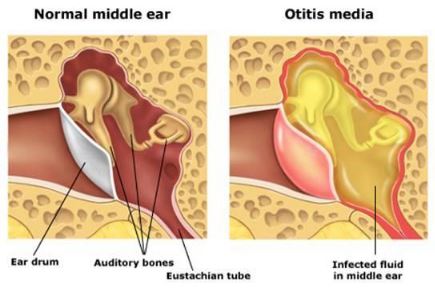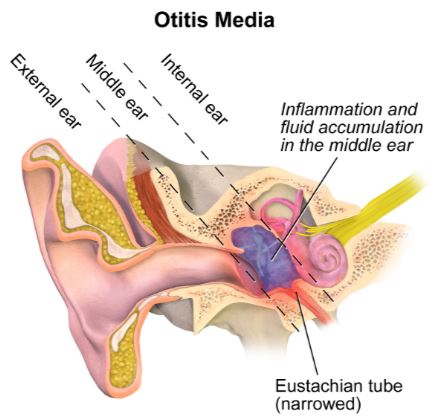Otitis Media
What is Otitis Media?
Otitis Media or ear infection had been suggested to be an unavoidable disease. Most of the time, symptomatic treatment is all that is required but this condition may lead to several complications [1].

Figure 1- Normal ear vs Otitis media
Otitis Media
Otitis media (OM) is the clinical term for the inflammation of the middle ear and the tympanic membrane. This medical condition is very common to children and it has been suggested that OM is part of the maturation of the child’s immune system.
OM is the general term that is used for the infection regardless of the etiology. There are different types of OM depending on the presenting signs and symptoms. Figure 1 shows what happen to the ear with an otitis media [1, 2].

Types
Acute Otitis Media
In an acute OM, the eustachian tube that runs from the middle part of the ear to the back of the throat is blocked. When the said tube is swollen or blocked, fluid will be trapped inside. This fluid can become infected and cause the symptoms. This condition is common to children because their Eustachian tube is more horizontal and shorter which makes it more prone to the infection [2, 3].
Chronic Otitis Media
Chronic, or recurring OM, is a condition where there is a recurring build-up of fluid in the plugged Eustachian tube. The build-up presses on the tympanic membrane and causes pain. If the condition is not managed, it may cause the eardrum to rupture [2, 4].
Chronic Suppurative Otitis Media
Chronic Suppurative OM is a result of an episode of an acute OM but is characterized by a persistent ear discharge due to the perforation of the tympanic membrane. Failing to treat this condition may lead to hearing loss [2, 5].
Serous Otitis Media
Serous OM or OM with effusion present with a non-purulent effusion in the middle ear. The said effusion is caused by the formation of transudate due to the quick reduction in the pressure in the middle ear relative to the atmospheric pressure [2, 6].
ICD10
The ICD-10-CM diagnosis code used for otitis media is H66.9. This code is for the inflammation, redness or swelling of the middle ear. There are 4 codes under this category depending on the side of the ear that is affected [7].
- H66.90- unspecified ear
- H66.91- right ear
- H66.92- left ear
- H66.93- bilateral ears
Causes
There are several factors that may contribute to the progression of OM [1, 2, 3].
Weak immune system and pathogens
The interplay between the pathogens and the weak immune system is important in the development of OM. This infection thrives in individuals with decreased immune defense. It is the pathogen Streptococcus pneumoniae that is considered to be the primary cause of OM. This organism, along with Moraxella catarrhalis and Haemophilus influenza make up around 95% of all OM cases [1, 2].
Abnormalities in anatomic structures
The presence of anatomic abnormalities increases the risk in developing OM. Examples of these abnormalities include cleft palate, Crouzon syndrome, Treacher Collins syndrome and Down syndrome [1, 2].
Infant feeding methods
Breast milk is reported to protect infants from OM. Those who are exclusively breastfed for the 1st 3-6 months of their lives are less likely to develop OM. Exclusive breastfeeding will protect an infant for 4-12 months after breastfeeding had stopped. This will not only delay the onset of OM but may also reduce the recurrence in these infants [1, 2].
Exposure to passive smoke
Several studies have proven the link between second hand smoke exposure and the risk of OM. Parental smoking increases the risk of the child to develop any type of OM [1, 2].
Signs and Symptoms
General symptoms
Almost 67% of the children with OM will present will fever but fevers greater than 40˚C are uncommon and may be related to development of complications. They may also present with nausea, vomiting and diarrhea. Children and infants may appear irritable due to the discomfort that they experience [1, 2].
Head and neck symptoms
Children may show signs of earache or otalgia through the pulling of the affected ear. Otalgia happens more frequently whenever a child is lying sown due to the increased eustachian tube dysfunction while they are in this position [2, 3].
Otorrhea or discharge coming from the middle ear may occur due to a perforated tympanic membrane or through another perforation in the ear. There may also be headache and recent symptoms of an upper respiratory tract infection (URTI) [1, 2, 3].
Diagnosis
Health history and physical examination
The physician will obtain more information on the symptoms that were experienced and any exposure to environmental risk factors. An otoscope will be used during the physical examination to assess the condition of the middle ear. Any swelling, redness, pus formation or perforation of the tympanic membrane will be detected with this instrument [2, 3].
Tympanometry
In this procedure, a small instrument will be inserted in the affected war to measure the air pressure inside. This test will be able to indicate the rupture of the ear drum [3].
Hearing Test
A hearing test may be performed by the physician to assess if the individual is experiencing any loss in hearing due to the infection [3].
Treatment
Symptomatic relief and home care
Most of otitis media infections are self-limiting and do not require any treatment. Symptoms, such as otalgia, may be bothersome to the patient and they may be given over-the-counter pain medications or ear drops. Applying a warm, moist washcloth on the inflamed ear may help in relieving the swelling.
Antibiotics are not prescribed right away to avoid the overuse and adverse reactions of these medications. They are only given to patients if the symptoms have not improve after the symptomatic relief medications [1, 2, 3].
Surgery
If the ear infection did not respond to the treatment or is recurring, a surgical procedure may be advised by the physician. This would include insertion of tiny tubes into the ear to allow the accumulated air and fluid to drain from the middle ear [1, 2, 3].
References
- Best Practices Journal. (2012). Otitis Media: a common childhood illness. Best Practices Journal, 25-29.
- Waseem, M. (2016, March 15). Otitis Media. Retrieved from eMedicine: http://emedicine.medscape.com/article/994656-overview#a2
- Kivi, R., & Yu, W. (2016, January 5). Acute Otitis Media. Retrieved from Healthline: http://www.healthline.com/health/ear-infection-acute#Overview1
- Martel, J. (2015, November 2). Chronic Ear Infection. Retrieved from Healthline: http://www.healthline.com/health/ear-infection-chronic#Overview1
- World Health Organization. (2004). Chronic suppurative otitis media: Burden of Illness and
- Management Options. Retrieved from World Health Organization: http://www.who.int/pbd/publications/Chronicsuppurativeotitis_media.pdf
- Higgins, T. J. (2016, February 4). Otitis Media with effusion. Retrieved from eMedicine: http://emedicine.medscape.com/article/858990-overview
- ICD10 Data. (2015). Otitis media, unspecified. Retrieved from ICD10 Data: http://www.icd10data.com/ICD10CM/Codes/H60-H95/H65-H75/H66-/H66.9
